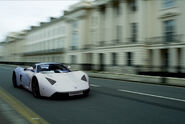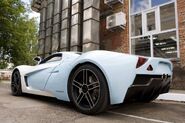
| |
| Marussia B1 | |
|---|---|
| Marussia | |
| aka | Type aka here, not up there |
| Production | 2008 -2014 |
| Class | Supercar |
| Body Style | 2-door, 2-seat Mid-Engined Coupe |
| Length | 4,635 mm (182.5 in) |
| Width | 2,000 mm (78.7 in) |
| Height | 1,100 mm (43.3 in) |
| Wheelbase | Unknown |
| Weight | 1,100 kg (2,425 lb) |
| Transmission | 6-speed automatic or 6-speed manual |
| Engine | 3.5L V6 or 2.8L Turbocharged V6 |
| Power | 420 horsepower and 443 lb-ft of torque. |
| Similar | Marussia B2 |
| Designer | Designer (lead designer if it was a team effort) |
Marussia Motors was founded in 2007 with its first car, the Marussia B1. The mid-engined, rear-wheel drive, 2 seater had various engine options ranging from a 3.5 liter naturally aspirated V6 to a 2.8 liter V6 twin-turbo which outputs 420 horsepower and 443 lb-ft of torque. The powerplant is bolted on to an aluminum frame with carbon fiber body panels, allowing the B1 to come in a little over 2,400 pounds. That amounts to a supercar spec 5.8 pounds per horsepower, making Marussia Motors Russia’s first ever sportscar company. The main requirement for the production is the use of the high-tech materials and components. Ideologists of the project Nikolay Fomenko and Yefim Ostrovsky believe that innovations and reliability are the key factors of the production under MARUSSIA trademark. Among the main car characteristics one can see a unique design of the vehicle exterior, which can be chosen in person; high operating performance; comfortable city driving.
See Autopedia's comprehensive Marussia B1 Review.
Recent Changes[]
After 2014, Many Unfinished Marussia B1s Were Found In A Facility Rotting And Slowly Becoming One With Nature.
Styles and Major Options[]
Certain vehicles come in different trim levels or body styles. Features and major options should be mentioned here.
Pricing[]
Add more fields as necessary.
| MODEL Trims | |||
|---|---|---|---|
| Basic | Sport | Sport+ | GT4 |
| MSRP | |||
| $Price1 | $Price2 | $Price3 | $Price4 |
| Invoice | |||
| $Price1 | $Price2 | $Price3 | $Price4 |
Gas Mileage[]
Add more fields as necessary.
As seen on the FuelEconomy.gov website, the City/Highway MPG averages are as follows:
| Trim | |||
|---|---|---|---|
| Trim1 | Trim2 | Trim3 | Trim4 |
| MPG | |||
| c/h | c/h | c/h | c/h |
Engine and Transmission[]
Engine power is 360 or 420 hp (268 or 313 kW), top speed is 305 km/h (190 mph) and it accelerates from 0–100 km/h (0-62 mph) in 3.2 seconds And All That Power Boogies Through A 6 Speed Manual Or Automatic.
Performance[]
Please make sure to write information of the vehicle's performance in a third-person point of view. This section should include information about the car's acceleration figures, handling, braking, etc.
If using information gathered from Road Test articles from a reputable automotive source, then please make sure to cite the quote.
Reliability[]
Warranty options and scheduled maintenance information should be mentioned here.
Safety[]
The energy-absorbing cockpit is a three part space frame of steel tubes of different sections. The front and rear subframes are attached to a central cell. In an impact, the subframes are designed to absorb energy by deforming. The B1 and В2 vehicles have passed Russian safety tests and obtained their certification from Russian crash testers
Photos[]
Add Photos of the vehicle here.
Please make sure not to use copyrighted photos.
Colors[]
- Blazing Red
- Misty Blue
- Bombastic Orange
- Spirt White
- Shadow Black
- Purple Overload
- Banana Yellow
Main Competitors[]
Hybrid Models[]
If there are hybrid versions of this vehicle manufactured, then please elaborate a little bit on it here.
Unique Attributes[]
Marussia designed the B1 around an aluminum shell and covered it in more carbon fiber than most supercars from that era. The carmaker followed Collin Chapman's idea to make a car light instead of powerful. But it didn't leave aside the aerodynamic. Since it was a mid-engined vehicle, it sported a slim front area with triangular headlights and a raked and curved windshield. Two front air intakes cooled the brakes and helped to increase the downforce. A pair of vents behind the front wheels released the air trapped in the wheel well. Behind the scissor-type doors, the carmaker made the air-intakes for cooling the twin-turbocharged engine.
Interior[]

Inside, the carmaker installed a leather-clad interior with hand-stitching. There was not a single analog dial in the cockpit. Marussia opted for a digital instrument panel and two additional touch screens: one on the center stack and the other on the passenger side. A pair of slim, high-bolstered bucket seats provided the side support needed during high-speed cornering.
Resale Values[]
Add more fields as necessary.
| <MODEL> Year | |||
|---|---|---|---|
| Year X | Year X-2 | Year X-3 | Year X-4 |
| Resale Value | |||
| $ | $ | $ | $ |
Criticisms[]
Please make sure to keep critiques in a third-person point of view. If using criticisms from a reputable automotive source, then please make sure to cite the quote.
Generations[]
Fill in as many as appropriate. Add more if necessary and pictures wherever applicable.
Please make sure NOT to use copyrighted pictures.
Current Generation: (YYYY–present)[]
Fifth generation (YYYY–YYYY)[]
Fourth generation (YYYY–YYYY)[]
Third generation (YYYY–YYYY)[]
Second generation (YYYY–YYYY)[]
First Generation/Origins (YYYY–YYYY)[]
Worldwide[]
The Marussia B1 Was Never Sold And All Unfinished Models Are Currently Abandoned.
Design quirks and oddities[]
Refer to any pop-culture tidbits about the vehicle in this section.
Awards[]
List out notable awards that the model has received while in production. Boldface the company or organization that gives out the award, and Italicize the name of the award.
See Also[]
Template:Marussia
External Links[]
Please include any external sites that were used in collaborating this data, including manufacturer sites, in this section.
News and References
Enthusiast Sites and Discussion Forums

















